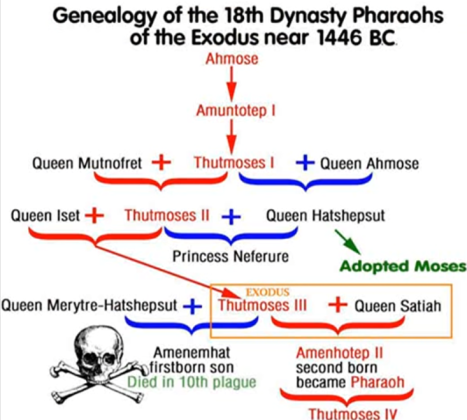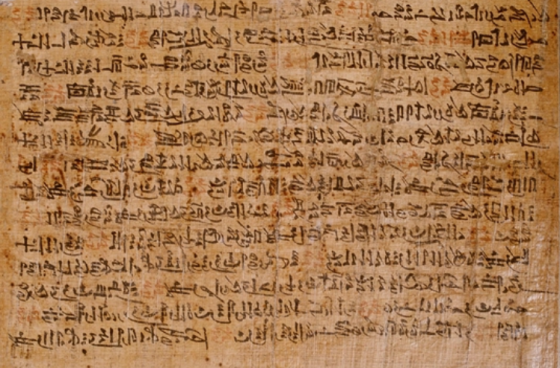Evidence for The Exodus in The ipuwer papyrus?
Wordpress article originally by Luchnia.
The search for more Evidence of The Exodus.
Here we look at The Ipuwer papyrus.
Dr. Titus Kennedy Ph.D says - paraphrased:
The copy dates to 13th Century BC.
If we look at details of the linguistics, they only come into use 18th Dynasty.
Or at least rewritten with that language....)
Dr. Titus Kennedy Ph.D also dates The ipuwer papyrus to Amenhotep ii.
While others, think Thutmose III. This gives a ballpark timeline for The Exodus.
(Image of suggested timeline outlining Thutmose's III (The 3rd).

Following transcript ( taken from a video interview link at end).
Dr. Titus Kennedy Ph. D:
(https://shepherds.edu/faculty-and-staff/titus-kennedy/)
So this is an Egyptian papyrus that dates to the 13th century BC, at least the copy
that we have. There’s only one copy known in existence today. It was composed
sometime before that, so before the 13th century bc. And the author his name was
ipuwer so that’s why it’s often called the ipuwer papyrus.
Now most scholars put the composition pretty early like at least the second intermediate period.
Some would even put it in the middle kingdom an past, some even pushed it farther back. But, if we look at details of the linguistics some of the words and phrases that are used there,
they only come into use in the 18th dynasty. And so it looks more like it was composed in
the 18th dynasty or at least rewritten with the language at that time.
Now the content is something that, got people interested in this text in
terms of connecting it to the exodus. Because in general it’s a poem that is talking
about destruction and death throughout the land of Egypt. But there are some
really interesting lines in there like, the river has turned to blood. So The Nile river is turned to blood. It’s (blood) all throughout the land of Egypt.
And that, you know people reading that they just immediately think oh, that feels like the exodus story. And so that’s where the connection initially came in.
But if you read through the text there are a variety of different components
that have parallels in the exodus story- (continued)...
Full interview at youtube title:
Historical Evidence for the Exodus from Egypt (with Titus Kennedy) with
Dr. Sean McDowell. Video timestamp 25:49.
The ipuwer papyrus English translation with notations follows:
Section II
Indeed, poor men have become owners of wealth, and he who could not make sandals for himself is now a possessor of riches.
Indeed, men’s slaves, their hearts are sad, and magistrates do not fraternize with their people when they shout.
Indeed, [hearts] are violent, pestilence is throughout the land, blood is everywhere, death is not lacking, and the mummy-cloth speaks even before one comes near it.
Indeed, many dead are buried in the river; the stream is a sepulcher and the place of embalmment has become a stream.
Indeed, noblemen are in distress, while the poor man is full of joy. Every town says: “Let us suppress the powerful among us.”
Indeed, men are like ibises. Squalor is throughout the land, and there are none indeed whose clothes are white in these times.

Indeed, the land turns around as does a potter’s wheel; the robber is a possessor of riches and [the rich man is become] a plunderer.
Indeed, trusty servants are [. . .]; the poor man [complains]: “How terrible! What am I to do?”
Indeed, the river is blood, yet men drink of it. Men shrink from human beings and thirst after water.
Indeed, gates, columns and walls are burnt up, while the hall of the palace stands firm and endures.
Indeed, the ship of [the southerners] has broken up; towns are destroyed and Upper Egypt has become an empty waste.
Indeed, crocodiles [are glutted] with the fish they have taken, for men go to them of their own accord; it is the destruction of the land. Men say: “Do not walk here; behold, it is a net.” Behold, men tread [the water] like fishes, and the frightened man cannot distinguish it because of terror.
Indeed, men are few, and he who places his brother in the ground is everywhere. When the wise man speaks, [he flees without delay].
Indeed, the well-born man [. . .] through lack of recognition, and the child of his lady has become the son of his maidservant.
A complete The ipuwer papyrus at this link:
Complete translation of the ancient Egyptian Ipuwer Papyrus with notes (potential confirmation of Moses and the Exodus). - Bible Blender
If the original link does not work, can find a not exact backup of the page, at wayback machine
Complete translation of the ancient Egyptian Ipuwer Papyrus with notes (potential confirmation of Moses and the Exodus). - Bible Blender
Wordpress article originally by Luchnia.
The search for more Evidence of The Exodus.
Here we look at The Ipuwer papyrus.
Dr. Titus Kennedy Ph.D says - paraphrased:
The copy dates to 13th Century BC.
If we look at details of the linguistics, they only come into use 18th Dynasty.
Or at least rewritten with that language....)
Dr. Titus Kennedy Ph.D also dates The ipuwer papyrus to Amenhotep ii.
While others, think Thutmose III. This gives a ballpark timeline for The Exodus.
(Image of suggested timeline outlining Thutmose's III (The 3rd).

Following transcript ( taken from a video interview link at end).
Dr. Titus Kennedy Ph. D:
(https://shepherds.edu/faculty-and-staff/titus-kennedy/)
So this is an Egyptian papyrus that dates to the 13th century BC, at least the copy
that we have. There’s only one copy known in existence today. It was composed
sometime before that, so before the 13th century bc. And the author his name was
ipuwer so that’s why it’s often called the ipuwer papyrus.
Now most scholars put the composition pretty early like at least the second intermediate period.
Some would even put it in the middle kingdom an past, some even pushed it farther back. But, if we look at details of the linguistics some of the words and phrases that are used there,
they only come into use in the 18th dynasty. And so it looks more like it was composed in
the 18th dynasty or at least rewritten with the language at that time.
Now the content is something that, got people interested in this text in
terms of connecting it to the exodus. Because in general it’s a poem that is talking
about destruction and death throughout the land of Egypt. But there are some
really interesting lines in there like, the river has turned to blood. So The Nile river is turned to blood. It’s (blood) all throughout the land of Egypt.
And that, you know people reading that they just immediately think oh, that feels like the exodus story. And so that’s where the connection initially came in.
But if you read through the text there are a variety of different components
that have parallels in the exodus story- (continued)...
Full interview at youtube title:
Historical Evidence for the Exodus from Egypt (with Titus Kennedy) with
Dr. Sean McDowell. Video timestamp 25:49.
The ipuwer papyrus English translation with notations follows:
Section II
Indeed, poor men have become owners of wealth, and he who could not make sandals for himself is now a possessor of riches.
Indeed, men’s slaves, their hearts are sad, and magistrates do not fraternize with their people when they shout.
Indeed, [hearts] are violent, pestilence is throughout the land, blood is everywhere, death is not lacking, and the mummy-cloth speaks even before one comes near it.
Indeed, many dead are buried in the river; the stream is a sepulcher and the place of embalmment has become a stream.
Indeed, noblemen are in distress, while the poor man is full of joy. Every town says: “Let us suppress the powerful among us.”
Indeed, men are like ibises. Squalor is throughout the land, and there are none indeed whose clothes are white in these times.

Indeed, the land turns around as does a potter’s wheel; the robber is a possessor of riches and [the rich man is become] a plunderer.
Indeed, trusty servants are [. . .]; the poor man [complains]: “How terrible! What am I to do?”
Indeed, the river is blood, yet men drink of it. Men shrink from human beings and thirst after water.
Indeed, gates, columns and walls are burnt up, while the hall of the palace stands firm and endures.
Indeed, the ship of [the southerners] has broken up; towns are destroyed and Upper Egypt has become an empty waste.
Indeed, crocodiles [are glutted] with the fish they have taken, for men go to them of their own accord; it is the destruction of the land. Men say: “Do not walk here; behold, it is a net.” Behold, men tread [the water] like fishes, and the frightened man cannot distinguish it because of terror.
Indeed, men are few, and he who places his brother in the ground is everywhere. When the wise man speaks, [he flees without delay].
Indeed, the well-born man [. . .] through lack of recognition, and the child of his lady has become the son of his maidservant.
A complete The ipuwer papyrus at this link:
Complete translation of the ancient Egyptian Ipuwer Papyrus with notes (potential confirmation of Moses and the Exodus). - Bible Blender
If the original link does not work, can find a not exact backup of the page, at wayback machine
Complete translation of the ancient Egyptian Ipuwer Papyrus with notes (potential confirmation of Moses and the Exodus). - Bible Blender

